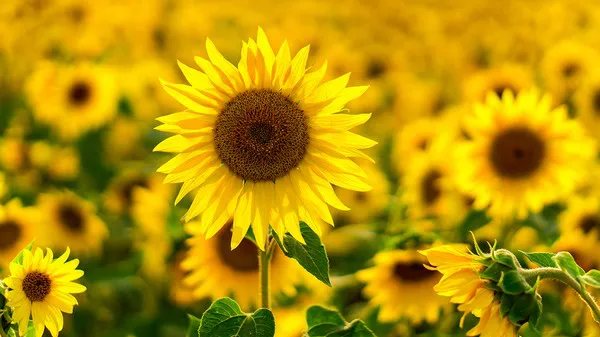Sunflowers, with their vibrant petals and towering stems, have long captured the imagination of artists, poets, and gardeners alike. These iconic flowers, known for their radiant beauty and striking appearance, hold a special place in both cultural symbolism and botanical fascination. In this comprehensive guide, we’ll delve into the world of sunflowers, exploring their origins, characteristics, and cultural significance. From their scientific classification to their role in art and literature, this article provides insights into the majesty and allure of sunflowers.
The Botanical Identity of Sunflowers: A Closer Look
Sunflowers, scientifically known as Helianthus annuus, belong to the Asteraceae family, which encompasses a vast array of flowering plants commonly referred to as aster or daisy family. Helianthus, derived from the Greek words “helios” (sun) and “anthos” (flower), aptly describes the sunflower’s characteristic behavior of turning its face towards the sun throughout the day. Sunflowers are native to North America, where they have been cultivated for thousands of years by indigenous peoples for their seeds, oil, and medicinal properties.
Sunflower Varieties: Exploring Diversity in Form and Color
While the classic image of a sunflower typically features a large, yellow flower with a dark center, there is actually a wide range of sunflower varieties, each with its unique characteristics. Traditional sunflower varieties, such as ‘Mammoth Russian’ or ‘Teddy Bear,’ boast large, single-headed blooms with bright yellow petals and dark brown centers. However, modern breeding efforts have led to the development of hybrid varieties with diverse colors, including shades of red, orange, and bi-color combinations. Additionally, there are dwarf sunflower varieties suitable for container gardening, as well as branching varieties that produce multiple flower heads on a single stem.
The Anatomy of a Sunflower: Understanding Structure and Function
Sunflowers exhibit a distinctive floral structure that contributes to their unique appearance and reproductive strategy. Each sunflower head is composed of numerous individual flowers, called florets, clustered together in a spiral pattern. The outer ring of florets, known as ray florets, features long, petal-like structures that radiate outward from the center, creating the appearance of petals. These ray florets serve to attract pollinators, such as bees and butterflies, to the flower. Meanwhile, the central disk florets, clustered densely in the center, contain the reproductive organs of the flower, including the stamens (male reproductive organs) and pistils (female reproductive organs).
See Also: How to plant flowers in a planter?
Cultural Significance of Sunflowers: From Mythology to Modern Symbolism
Throughout history, sunflowers have held symbolic significance in various cultures and societies around the world. In ancient Greek mythology, the sunflower was associated with the sun god Helios and represented loyalty, adoration, and the pursuit of light and truth. Native American tribes revered the sunflower as a symbol of vitality, fertility, and sustenance, using it for food, medicine, and ceremonial purposes. In modern times, sunflowers have become emblematic of positivity, optimism, and resilience, often associated with concepts of warmth, happiness, and growth. Their vibrant blooms and cheerful demeanor have made them popular subjects in art, literature, and folklore.
Sunflowers in Art and Literature: Inspiring Creativity and Expression
Sunflowers have captivated the imagination of artists and writers throughout history, inspiring countless works of art, poetry, and literature. One of the most famous depictions of sunflowers is Vincent van Gogh’s series of paintings, including “Sunflowers” or “Tournesols,” which are celebrated for their vivid colors and expressive brushwork. These iconic works have become synonymous with van Gogh’s artistic legacy and are revered for their emotional depth and beauty. In literature, sunflowers have been celebrated in poems, novels, and children’s stories, serving as symbols of hope, growth, and the beauty of nature.
Cultivation and Care of Sunflowers: Tips for Growing Success
Growing sunflowers can be a rewarding experience, whether you’re cultivating them for their ornamental beauty or harvesting their nutritious seeds. Sunflowers are relatively easy to grow and thrive in full sunlight and well-draining soil. When planting sunflower seeds, choose a location with plenty of sunlight and space for the tall stems to grow. Sow the seeds directly into the ground or in containers, ensuring they are spaced adequately to allow for proper air circulation and growth. Keep the soil consistently moist but not waterlogged, especially during the germination and flowering stages. As the sunflowers grow, provide support for the tall stems if needed, using stakes or trellises to prevent them from toppling over in strong winds.
Harvesting Sunflower Seeds: Nurturing Nature’s Bounty
One of the most appealing aspects of growing sunflowers is the opportunity to harvest their nutritious seeds for culinary use or bird feed. Sunflower seeds are rich in protein, healthy fats, vitamins, and minerals, making them a popular snack or ingredient in various dishes. To harvest sunflower seeds, wait until the flower heads have matured and the back of the head turns brown. Cut the flower heads from the stem and hang them upside down in a dry, well-ventilated area to dry completely. Once dry, remove the seeds from the flower head by rubbing them gently or using your fingers. Store the harvested seeds in an airtight container in a cool, dry place for long-term storage and enjoyment.
Conclusion
In conclusion, sunflowers stand as vibrant symbols of beauty, resilience, and optimism, captivating hearts and minds around the world. From their botanical structure to their cultural significance, sunflowers embody the majesty and allure of nature’s creations. Whether adorning gardens, inspiring works of art, or nourishing bodies and souls, sunflowers continue to enchant and inspire with their radiant blooms and uplifting presence.


